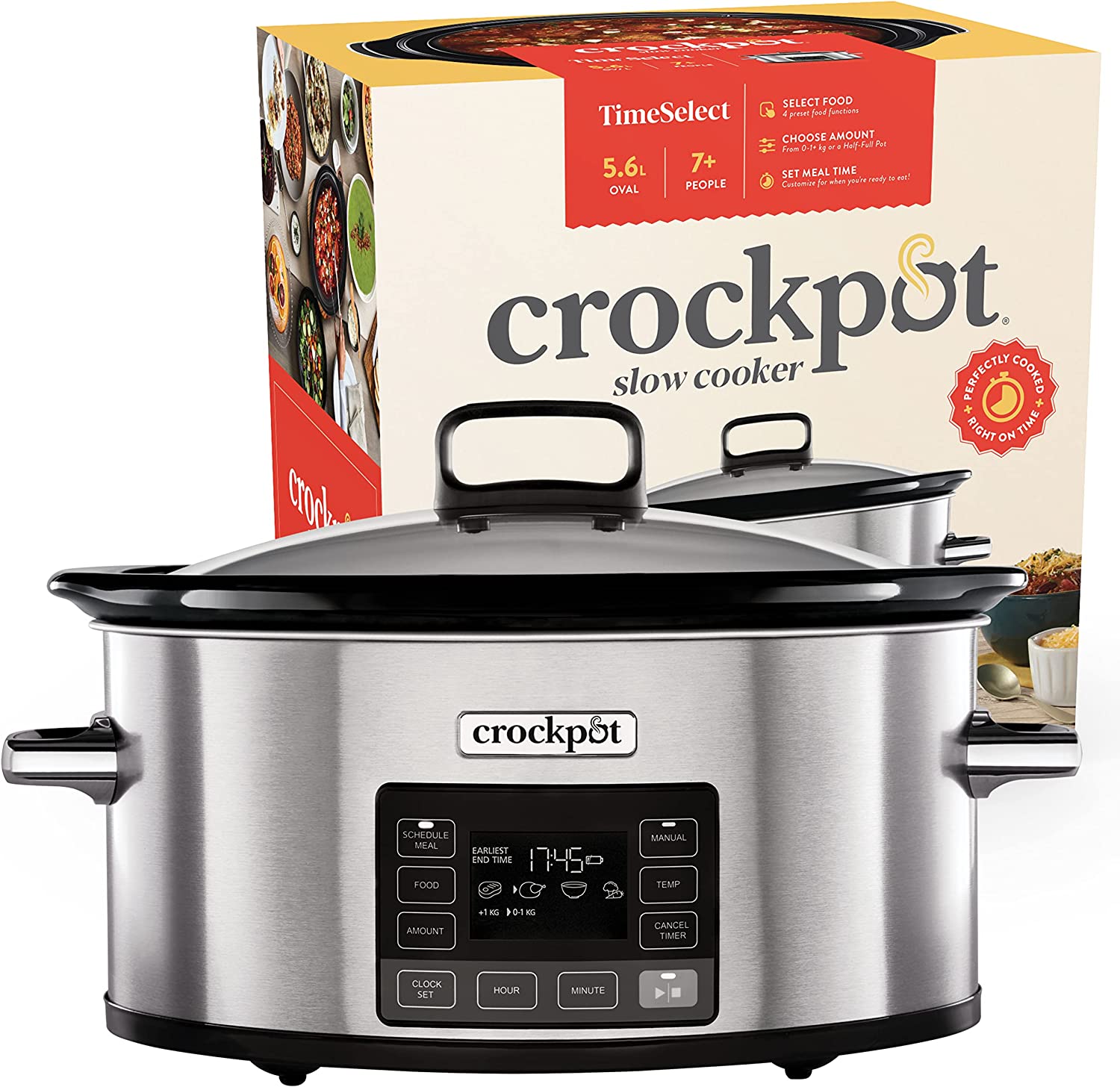9 Energy-Saving Cooking Techniques that Will Change Your Life
In a world grappling with environmental challenges and the need for sustainable practices, energy conservation has emerged as a crucial aspect of our daily lives.
Cooking is a great example of this.
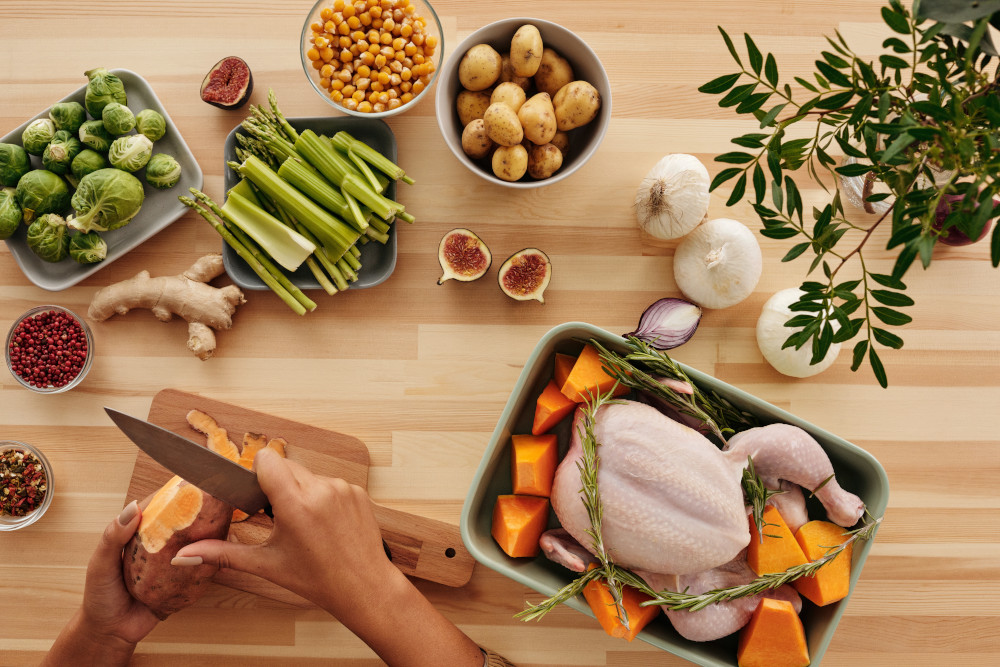
Energy-saving cooking techniques not only contribute to environmental preservation but also offer economic benefits by reducing energy consumption and lowering utility bills.
Let’s take a look at some practical tips on energy-saving cooking techniques that can help us minimize our impact on the planet while still making delicious meals.
Choosing the Right Cookware
The first step toward energy-saving cooking begins with selecting appropriate cookware.

- Material: Look for cookware made from materials that conduct heat efficiently like stainless steel, copper, cast iron, and aluminium. These materials distribute heat evenly and hold heat well, reducing the need for high heat settings.
- Bottom Thickness: Cookware with a thick, heavy bottom tends to distribute heat more evenly. The thickness helps retain heat and prevents hot spots, allowing for lower heat settings during cooking.
- Flat Bottom: Ensure that the cookware has a flat bottom to maximize contact with the heat source. A flat bottom ensures better heat transfer and reduces energy waste.
- Size and Shape: Choose cookware that matches the size of your burners or cooking zones. Using a pan or pot that is too small or too large for the burner wastes energy. Select cookware that fits the burner diameter to prevent heat loss.
- Lids: Look for cookware that comes with tight-fitting lids. Lids help trap heat and steam inside the cookware, reducing cooking time and energy consumption. When using a lid, you can often lower the heat setting without compromising cooking performance.
- Nonstick Coating: Nonstick cookware can be energy-efficient because it allows for lower heat settings during cooking. The nonstick coating helps prevent food from sticking to the pan, reducing the need for excessive oil or high heat.
- Induction Compatibility: If you have an induction hob, ensure that your cookware is compatible. Induction hobs require magnetic materials like stainless steel or cast iron to work efficiently.
- Oven-Safe Cookware: Look for cookware that is oven-safe. Oven-safe cookware allows for versatile cooking techniques and reduces the need for additional energy-consuming appliances.
- Energy-Efficient Appliances: Consider using energy-efficient appliances like pressure cookers or slow cookers. These appliances utilize less energy while cooking and can significantly reduce cooking times.
- High-Quality Construction: Invest in high-quality cookware that will last longer and perform better. Well-constructed cookware ensures even heat distribution and efficient cooking, saving energy in the long run.
- Maintenance: Proper maintenance and care of your cookware are important for its longevity and energy efficiency. Follow the manufacturer’s instructions for cleaning and storage to ensure optimal performance.
Efficient Use of gas Hobs
One of the best energy-saving cooking techniques is the correct use of gas hobs.
They are notorious energy guzzlers, but with mindful practices, their efficiency can be maximized.
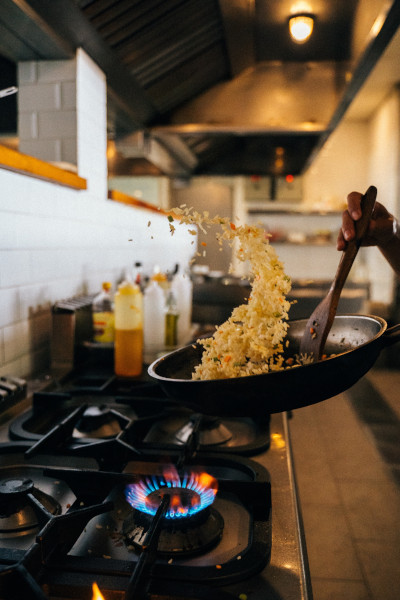
- Match Cookware to Burner Size: Use pots and pans that match the size of the burner. Using a small pot on a large burner wastes heat, while using a large pot on a small burner leads to uneven cooking and energy loss.
- Use the Right Burner: Choose the appropriate burner for the size of the cookware and the cooking task. Smaller burners are ideal for low-heat simmering, while larger burners are best for high-heat tasks like boiling water. Using the right burner prevents energy waste and improves cooking efficiency.
- Keep Burners Clean: Regularly clean the stovetop burners to ensure optimal heat transfer. Built-up residue or grease can obstruct heat flow, resulting in longer cooking times and increased energy consumption.
- Use Flat-Bottomed Cookware: Flat-bottomed cookware provides better contact with the burner, allowing for efficient heat transfer. Flat surfaces ensure even distribution of heat and prevent energy loss.
- Use Lids: Cover pots and pans with lids whenever possible. Lids help retain heat, reduce cooking time, and minimize heat loss. With a lid on, you can often lower the heat setting while maintaining the desired cooking temperature.
- Simmer Efficiently: When simmering liquids, bring them to a boil first, then reduce the heat to maintain a gentle simmer. Simmering on high heat wastes energy and can cause excessive evaporation.
- Utilize Residual Heat: After turning off the burner, take advantage of residual heat by leaving the pot or pan on the stovetop. The retained heat will continue cooking the food without using additional energy.
- Size Batch Cooking: If you’re cooking multiple dishes, try to batch similar items together. This allows you to maximize the use of the burners and reduce overall cooking time and energy consumption.
- Keep Burners Aligned: Ensure that the cookware is centred on the burner and properly aligned. This ensures that the flames or heat elements are in direct contact with the cookware, preventing energy loss.
Harnessing the Power of Pressure Cookers
Pressure cookers have long been recognized for their ability to reduce cooking time and save energy.
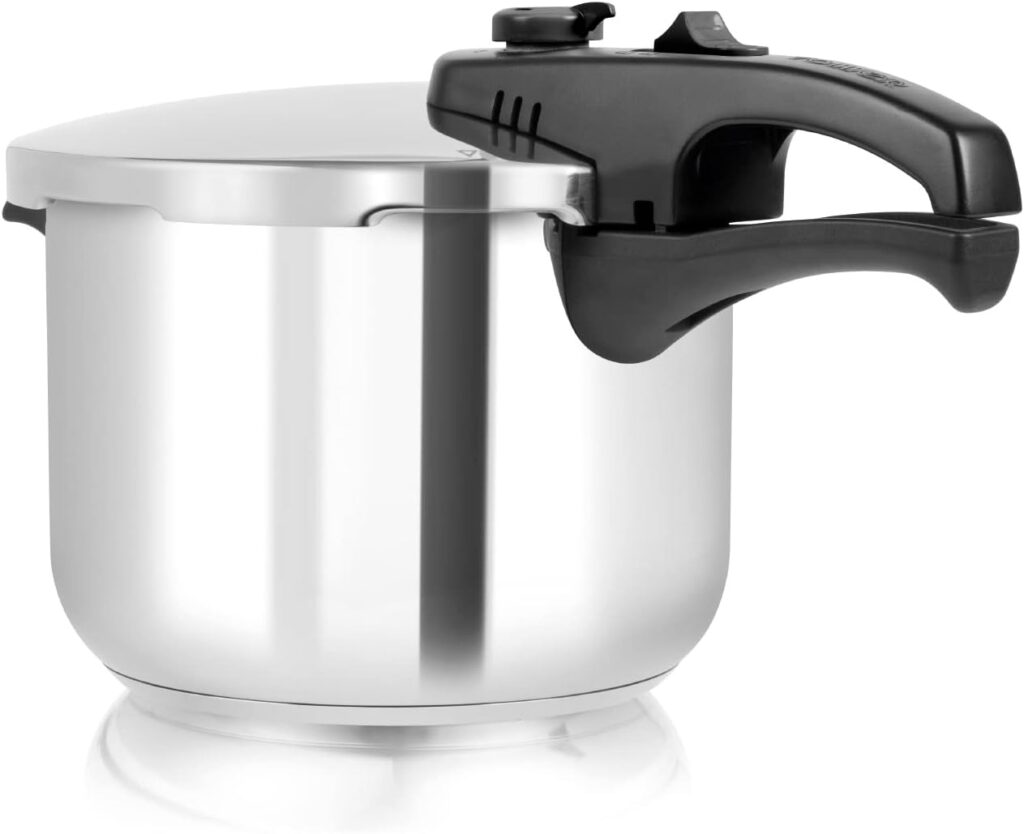
These sealed vessels trap the steam, creating high pressure and temperatures that cook food faster than conventional methods.
Using a pressure cooker, you can cut cooking time by up to 70% compared to traditional stovetop or oven cooking.
- Choose the Right Size: Select a pressure cooker size that matches your cooking needs. Using a larger pressure cooker than necessary will require more time and energy to reach the desired pressure.
- Use the Minimum Required Liquid: Pressure cookers require a minimal amount of liquid to create steam and build pressure. Follow the manufacturer’s guidelines for the recommended liquid amount, as using excessive liquid can increase cooking time and energy consumption.
- Cut Food into Uniform Pieces: To ensure even and efficient cooking, cut food into uniform pieces. Smaller, evenly-sized pieces will cook faster, reducing cooking time and energy usage.
- Utilize the Pressure Release Methods: Pressure cookers typically offer two pressure release methods: natural release and quick release. The natural release allows the pressure to release gradually, utilizing residual heat to finish cooking. Quick release releases pressure rapidly but may require additional energy to cool down the pressure cooker.
- Preheat Ingredients and Pressure Cooker: Preheating ingredients before adding them to the pressure cooker can help reduce the time needed to reach pressure. Additionally, preheating the pressure cooker itself can speed up the cooking process.
- Do Not Overfill: Avoid overfilling the pressure cooker to ensure proper heat distribution and pressure buildup. Leave sufficient headspace as recommended by the manufacturer to allow for expansion during cooking.
- Use the Right Heat Setting: Once the pressure cooker reaches the desired pressure, lower the heat to the appropriate setting. High heat is not required throughout the cooking process and can lead to unnecessary energy consumption.
- Cook Multiple Items Together: If you have multiple dishes to prepare, consider stacking compatible ingredients in separate containers within the pressure cooker. This allows you to cook multiple items simultaneously, optimizing energy usage.
- Plan Cooking Time Wisely: Take advantage of the shorter cooking times in pressure cookers by planning your meals accordingly. Start with ingredients that require longer cooking times and add those with shorter cooking times later to optimize energy usage.
- Use Residual Heat: Once cooking is complete, take advantage of the residual heat inside the pressure cooker. Turn off the heat and allow the pressure cooker to naturally release pressure while using the residual heat to keep the food warm.
- Maintain and Clean Regularly: Proper maintenance and cleaning of the pressure cooker ensure optimal performance. Follow the manufacturer’s instructions for care, which may include checking the gasket, valves, and safety features to ensure energy-efficient operation.
For Pressure Cookers, we recommend:
We recommend this brilliant Tower Pressure Cooker on Amazon
Check PriceIf you click this link and make a purchase, we earn a commission at no additional cost to you.
Embracing the Slow Cooker
The slow cooker, also known as a crock-pot, is a versatile kitchen appliance that can help conserve energy.
Slow cooking relies on low heat and longer cooking times, utilizing less electricity compared to traditional cooking methods.
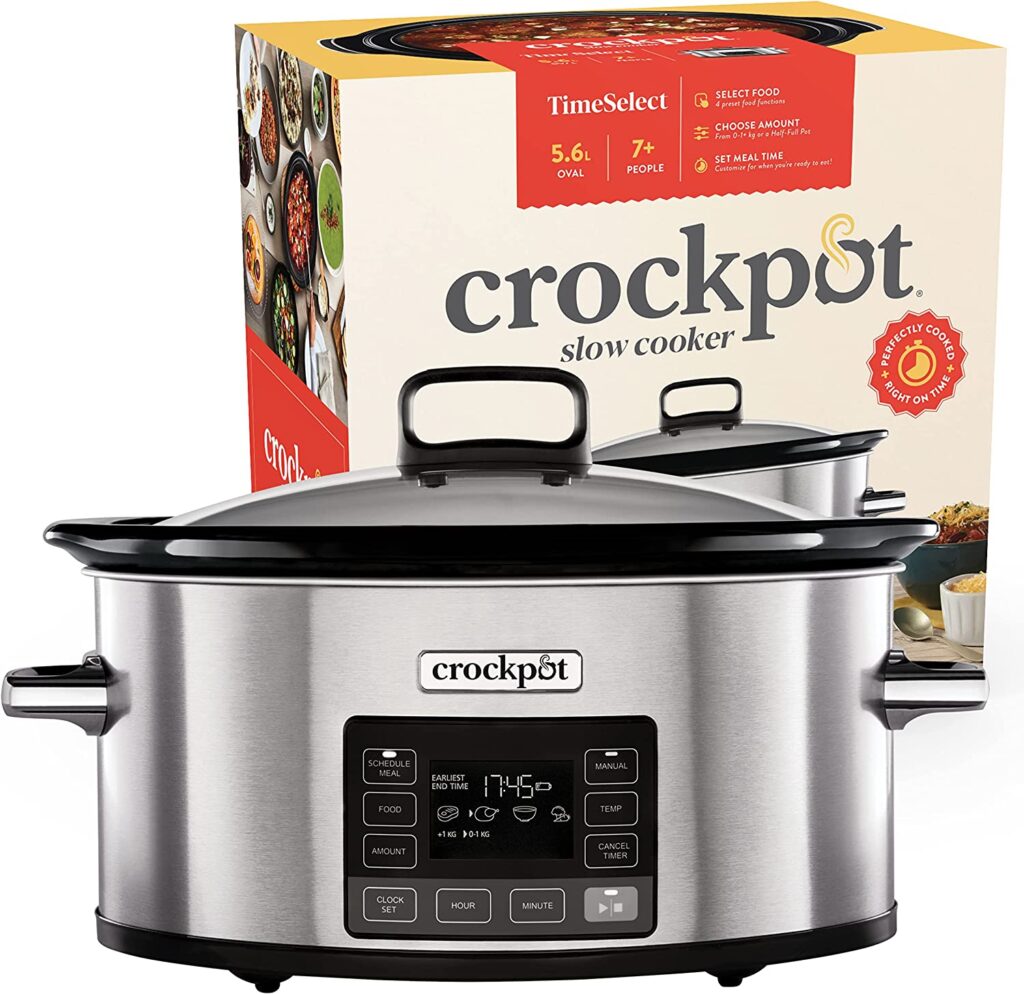
- Choose the Right Size: Select a slow cooker that matches your cooking needs. Using a larger slow cooker than necessary will require more energy to heat up and maintain the cooking temperature.
- Preheat Wisely: Preheating is not necessary for slow cookers. Simply add the ingredients to the slow cooker and turn it on to the desired temperature setting. Preheating can waste unnecessary energy and prolong the cooking time.
- Plan Ahead: Slow cookers work best when you can allow for longer cooking times. Plan your meals in advance to ensure that you have sufficient time to cook at a lower temperature setting, which consumes less energy.
- Use the Low Setting: The low setting is usually sufficient for most recipes. It consumes less energy and allows for longer cooking times, resulting in tender and flavorful dishes.
- Fill It Appropriately: Slow cookers work most efficiently when they are at least halfway filled, but not more than two-thirds full. This allows for proper heat circulation and avoids the risk of overfilling.
- Layer Ingredients Properly: Layer the ingredients in the slow cooker according to the recipe instructions. Place the denser, longer-cooking ingredients at the bottom and the more delicate ingredients on top. This ensures even cooking and efficient energy usage.
- Avoid Lifting the Lid: Every time you lift the lid, heat escapes, and it takes time to regain the desired temperature. Avoid unnecessary lid lifting to minimize heat loss and maintain energy efficiency.
- Optimize Cooking Time: Slow cookers are designed to cook food slowly over a longer period. If you’re going to be away for an extended time, set it to a lower temperature setting and allow it to cook for a longer duration, maximizing energy efficiency.
- Utilize Residual Heat: After the cooking time is complete, most slow cookers will keep the food warm for some time. Take advantage of this residual heat and turn it off. The stored heat will continue to keep the food warm without using additional energy.
- Choose Energy-Efficient Recipes: Look for recipes specifically designed for slow cookers. These recipes are typically created with longer cooking times and lower temperature settings in mind, ensuring optimal energy efficiency.
- Use Thick Cuts of Meat: Slow cookers are well-suited for tougher cuts of meat that benefit from the low and slow cooking method. These cuts require less energy to break down the fibers and become tender and flavorful.
- Clean and Maintain Regularly: Proper maintenance, including regular cleaning, ensures the slow cooker operates efficiently. Follow the manufacturer’s instructions for care, such as cleaning the removable parts and ensuring the electrical components are in good condition.
For a Slow Cooker, we recommend:
Check out the Crockpot 5.6l Slow Cooker on Amazon
Check PriceIf you click this link and make a purchase, we earn a commission at no additional cost to you.
Utilizing Microwaves and Induction Cooktops
Microwaves and induction hobs offer efficient alternatives to conventional stovetops and ovens.
Microwaves
Microwaves cook food by emitting electromagnetic waves that directly heat the food, reducing cooking time significantly.
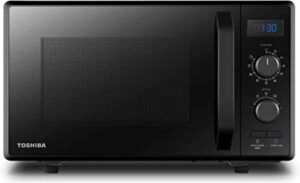
Here’s why they are considered efficient:
- Speed: Microwaves cook food much faster than conventional ovens or hobs. They use microwaves to directly heat the food, resulting in shorter cooking times and reduced energy consumption.
- Targeted Heating: Microwaves heat the food directly, unlike traditional ovens that heat the surrounding air. This targeted heating minimizes energy waste by avoiding unnecessary heat loss to the surroundings.
- Size and Portion Control: Microwaves are ideal for cooking small portions or reheating leftovers. Their compact size and ability to heat food quickly reduce energy consumption compared to using a larger oven for small tasks.
- No Preheating: Unlike ovens, microwaves don’t require preheating. You can start cooking or reheating immediately, saving time and energy.
- Efficient Defrosting: Microwaves have specific defrosting settings that thaw food efficiently and quickly without wasting energy on running water or extended refrigerator defrosting times.
For Microwaves, we recommend:
Check out the Toshiba Combination Microwave on Amazon
Check PriceIf you click this link and make a purchase, we earn a commission at no additional cost to you.
Induction Hob
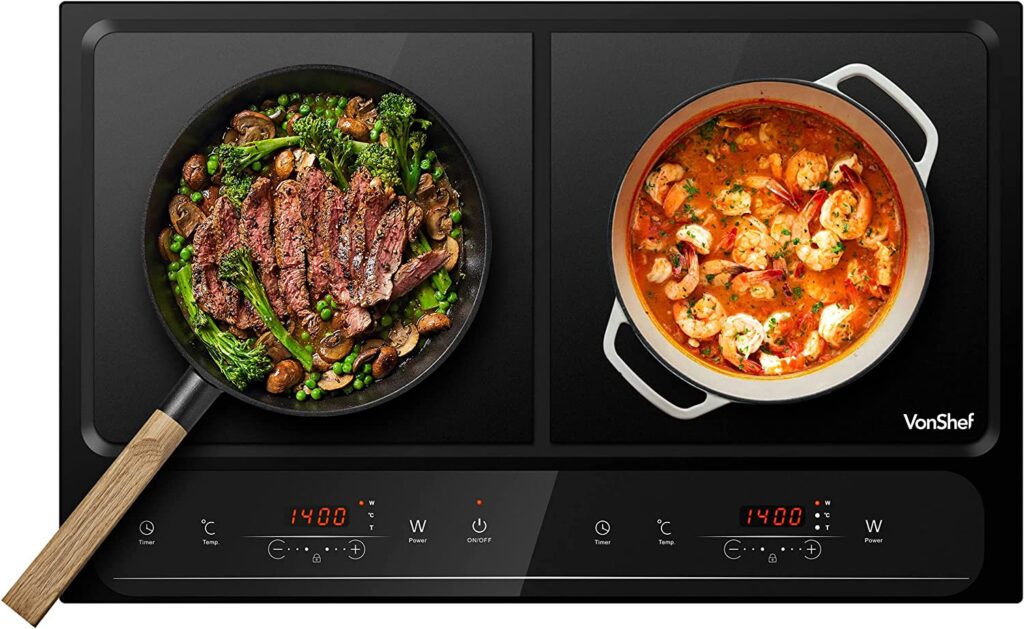
Induction Hobs offer several advantages in terms of energy efficiency and precision cooking:
- Energy Transfer: Induction hobs use magnetic fields to directly heat the cookware. They heat up quickly and transfer energy directly to the pot or pan, resulting in minimal heat loss to the surrounding environment.
- Precise Temperature Control: Induction hobs provide precise temperature control, allowing you to adjust heat levels instantly. This responsiveness helps prevent energy waste from overshooting or prolonged cooking times.
- Faster Cooking: Induction hobs heat up faster than traditional gas or electric cooktops. The rapid heating reduces cooking time, ultimately saving energy.
- Safety Features: Induction hobs have safety features that automatically shut off the heat when the cookware is removed or the cooking time is completed. This feature prevents energy waste and reduces the risk of accidents.
- Easy Cleaning: Induction hobs have a smooth surface, making them easy to clean. Their flat surface eliminates the need for excessive scrubbing, saving water and energy during cleaning.
- Cool Surface: The surface of an induction hobs remains relatively cool, reducing the risk of burns and minimizing wasted energy from the heat radiating into the kitchen.
- Efficiency with Cookware: Induction hobs work best with cookware specifically designed for induction cooking. By using induction-compatible cookware, the energy transfer is optimized, and cooking efficiency is maximized.
Check out the VonShef Double Induction Hobon Amazon
Check PriceIf you click this link and make a purchase, we earn a commission at no additional cost to you.
Energy-Efficient Oven Usage
Energy-efficient oven usage is crucial in minimizing energy consumption while cooking.

Here are some techniques to optimize oven usage and reduce energy waste:
- Preheating: Preheat the oven only when necessary. Many recipes do not require preheating, especially for longer cooking times or dishes that can be placed in a cold oven. Check the recipe instructions to determine if preheating is essential.
- Proper Rack Placement: Adjust the oven racks to the appropriate position based on the size of the dish you’re cooking. Placing dishes too high or too low in the oven can lead to uneven cooking and longer cooking times. Follow the recipe instructions for optimal rack placement.
- Batch Cooking: Whenever possible, cook multiple dishes simultaneously to make the most of the oven’s heat. By utilizing the residual heat from one dish to cook another, you reduce the overall energy consumption. Just ensure that the dishes require similar cooking temperatures and times.
- Door Management: Avoid frequently opening the oven door while cooking. Opening the door releases heat, causing the oven to work harder to regain the desired temperature. Use the oven light and window to monitor progress instead.
- Size Matters: Use the appropriately sized oven for your cooking needs. If you’re cooking a small portion, consider using a countertop toaster oven or microwave instead of the full-size oven. These smaller appliances consume less energy for smaller quantities.
- Proper Cookware: Use oven-safe cookware that conducts heat efficiently. Good-quality cookware distributes heat evenly, reducing the cooking time and ensuring consistent results. Avoid using excessively large or small cookware for the dish you’re preparing.
- Timed Cooking: Use a timer or alarm to remind you when the cooking time is complete. Overcooking not only wastes energy but also affects the taste and texture of the food. Set a timer to avoid unnecessary energy consumption.
- Regular Maintenance: Keep your oven clean and well-maintained. A dirty oven can interfere with proper heat distribution and efficiency. Regularly clean the oven, including the door seals, to ensure optimal performance.
- Unplugging or Powering Off: When you’ve finished using the oven, remember to turn it off or unplug it. Ovens often consume standby power when not in use, contributing to energy waste. Be mindful of energy conservation by completely powering down the oven when not needed.
Proper Meal Planning
Proper meal planning is not only beneficial for saving time and reducing stress in the kitchen but also plays a significant role in energy conservation.
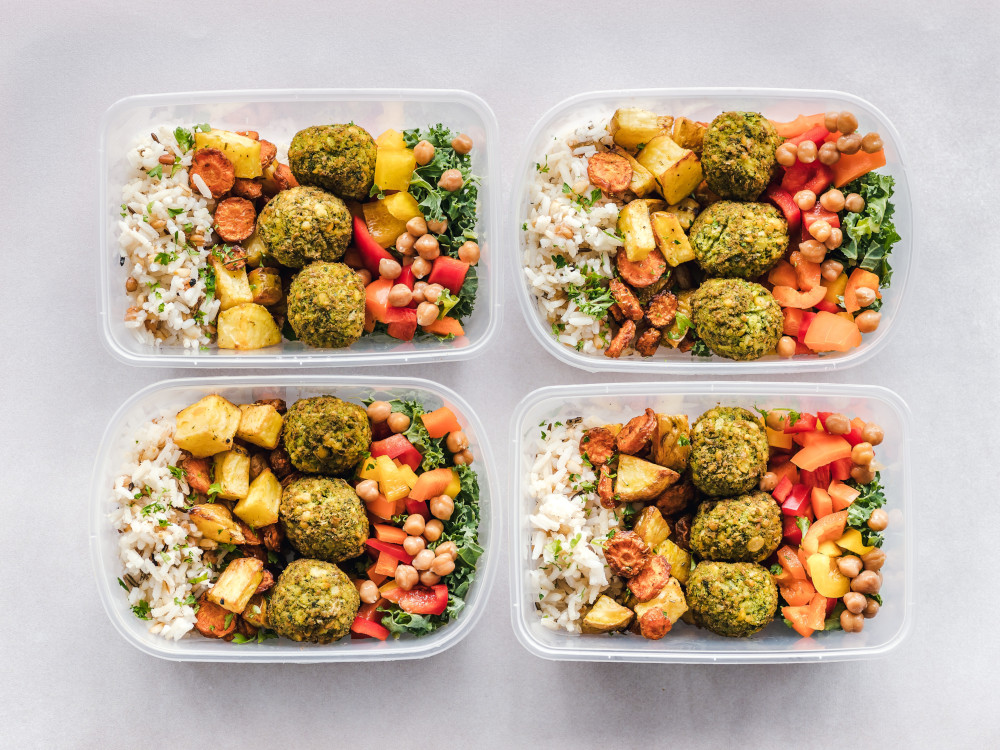
Here are some energy-saving tips through effective meal planning:
- Plan Ahead: Set aside some time each week to plan your meals. Consider the number of days you need to plan for and take into account any leftovers or ingredients that can be repurposed. This helps you avoid last-minute cooking decisions, which often result in inefficient energy use.
- Cook in Batches: Optimize your cooking time and energy usage by preparing larger quantities of food that can be stored and reheated for future meals. This approach allows you to utilize the oven or stove efficiently and minimize energy waste.
- Opt for One-Pot or Sheet Pan Meals: Choose recipes that allow you to cook multiple components of a meal in a single pot or on a sheet pan. By combining ingredients and cooking them together, you can save energy by reducing the number of pots, pans, and burners required.
- Utilize Simultaneous Cooking: When planning your meals, consider dishes that can be cooked simultaneously. This approach maximizes the use of the oven or stovetop, reducing overall cooking time and energy consumption. Ensure that the recipes have similar cooking temperatures and compatible cooking times.
- Take Advantage of Prepping: Prepare ingredients in advance. By having ingredients ready to go, you can minimize the time the stove or oven needs to be on and reduce energy waste.
- Utilize Residual Heat: Take advantage of residual heat by turning off the stove or oven a few minutes before the designated cooking time is complete. The retained heat will continue cooking the food without using additional energy.
- Plan Cold or No-Cook Meals: Incorporate cold or no-cook meals into your meal plan, especially during warmer months. Salads, sandwiches, wraps, and raw food preparations require minimal energy usage, as they often do not require any cooking.
- Optimize Freezer Storage: If you have excess food or leftovers, properly store them in the freezer for future use. This eliminates food waste and allows you to plan meals around already prepared ingredients, reducing the need for additional cooking and energy consumption.
Utilizing Residual Heat
Utilizing residual heat when cooking is a simple yet effective way to reduce energy consumption in the kitchen.
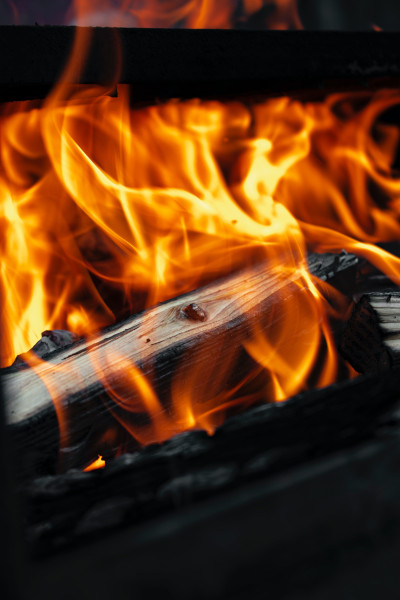
Here are some techniques to make the most of residual heat:
- Timing: As you approach the end of the cooking time, turn off the heat on the stove or oven a few minutes earlier than required. The retained heat will continue cooking the food without the need for additional energy.
- Simmering: For dishes that require simmering, such as soups, stews, or sauces, turn off the heat once the liquid reaches a simmer. The residual heat will continue to cook the ingredients gently while flavours develop further.
- Resting: After removing food from direct heat, allow it to rest before serving. This is particularly applicable to meats, poultry, and baked goods. During the resting period, residual heat continues to cook the food internally, ensuring even doneness and enhanced flavours.
- Carryover Cooking: Understand the concept of carryover cooking, which refers to the phenomenon where food continues to cook even after being removed from the heat source. Account for carryover cooking by slightly undercooking foods, as they will reach the desired doneness during the resting period.
- Keep the Lid On: When using pots or pans on the hob, especially when simmering or boiling, keep the lid on during the last few minutes of cooking. The trapped heat will continue to cook the food, and the retained steam will help tenderize ingredients.
- Insulated Cookware: Utilize insulated cookware, such as thermal pots or insulated baking dishes. These vessels retain heat exceptionally well, allowing food to continue cooking even after being removed from the heat source.
- Carryover Grilling: When grilling meats, consider carryover cooking by removing them from the grill a couple of degrees below the desired internal temperature. Allow the residual heat to finish cooking the meat while it rests.
- Slow Cooker Switch-Off: Slow cookers retain heat effectively. Therefore, once the cooking time is complete, turn off the slow cooker and let the dish rest in the pot. The residual heat will keep the food warm and continue to develop flavours.
- Plan Timing Wisely: Adjust your cooking schedule so that dishes that require less cooking time can be prepared last. This way, you can utilize residual heat from dishes that finish cooking earlier to keep subsequent dishes warm or continue cooking.
Efficient Water Usage
Efficient water usage during cooking is not only environmentally friendly but also helps conserve water resources.
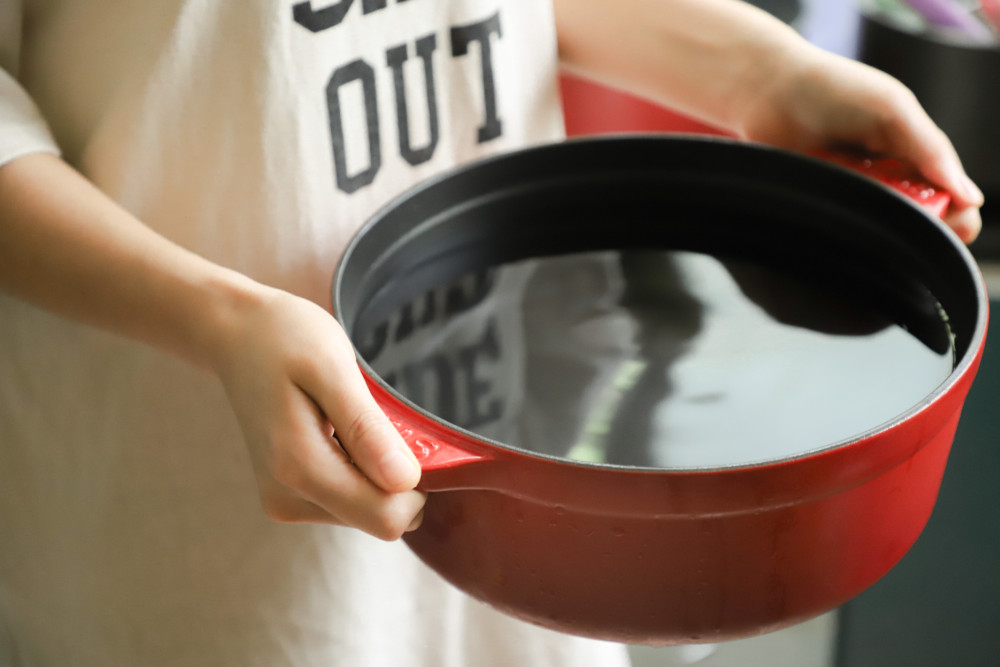
Here are some tips for optimizing water usage in the kitchen:
- Measure Water Accurately: Use measuring cups or a kitchen scale to measure the exact amount of water needed for cooking. This prevents overfilling pots or using more water than necessary.
- Use Minimal Water: When boiling or steaming ingredients, use the minimum amount of water required to cover the food. Excess water increases boiling time and energy consumption.
- Reuse Cooking Water: Instead of draining cooking water down the sink, consider reusing it in other culinary preparations. For example, use vegetable cooking water as a base for soups or sauces, or save pasta water to enhance the consistency of sauces.
- Optimize Pot Size: Select a pot or pan that matches the size of the dish being prepared. Using a larger pot than necessary requires more water to cover the ingredients, wasting water and energy.
- Use Water-Saving Appliances: If available, use energy-efficient appliances like pressure cookers or steamers that require less water and reduce cooking time.
- Soak Instead of Running Water: When cleaning fruits, vegetables, or dishes, consider using a basin or sink filled with water to soak and rinse them, rather than letting the water run continuously.
- Defrost in the Refrigerator: Instead of using running water to thaw frozen foods, plan ahead and defrost them in the refrigerator overnight. This method is not only water-efficient but also helps conserve energy.
- Collect and Reuse Water: Place a bowl or bucket in the sink while waiting for the water to reach the desired temperature. Use this collected water for watering plants or other non-potable purposes.
- Steam Vegetables: Opt for steaming vegetables instead of boiling them. Steaming requires less water and preserves more nutrients, flavours, and textures in the food.
- Monitor Water Evaporation: When simmering or boiling ingredients, cover the pot with a lid to reduce water evaporation. This helps retain heat, speeds up cooking time, and saves water.
- Capture and Reuse Pasta Water: Save a portion of the water used to boil pasta, especially when it’s starchy. This water can be used to adjust the consistency of sauces or as a binding agent for certain recipes.
- Use Dishpans for Washing: When handwashing dishes, use dishpans or basins for washing, rinsing, and soaking. This allows you to control the amount of water used more effectively compared to running water continuously.
Energy-Saving Cooking Techniques: The Conclusion
Energy-saving cooking techniques are not only environmentally friendly but also allow us to enjoy delicious meals while reducing energy costs.
By selecting the right cookware, utilizing stovetops efficiently, embracing pressure cookers and slow cookers, and leveraging the benefits of microwaves and induction hobs, we can make a significant impact on our energy consumption in the kitchen.
Incorporating these techniques into our daily culinary routines will not only help conserve resources but also promote sustainable living for future generations.
Let us embrace the power of energy-saving cooking and savour the flavours while protecting our planet.


